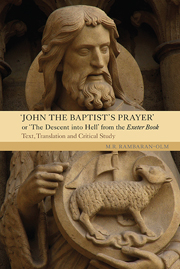 John the Baptist's Prayer 'The Descent into Hell' from the Exeter Book
John the Baptist's Prayer 'The Descent into Hell' from the Exeter Book Book contents
- Frontmatter
- Contents
- Illustrations
- Acknowledgements
- Abbreviations
- Dedication
- Introduction
- 1 Palaeography, Codicology and Language
- 2 The Descensus Motif
- 3 Literary Analysis
- 4 Selected Comparative Studies and Analogous Literature
- Afterword
- Text and Translation
- Commentary
- Appendix 1 The Doctrine of the Descensus according to Post-Apostolic and Medieval Commentators from the First Century to the End of the Eleventh Century
- Appendix 2 Scriptural References
- Appendix 3 Other Sources and Analogues
- Appendix 4 Transcription and Images of fol. 120r
- Glossary
- Biblioigraphy
- Index
Appendix 1 - The Doctrine of the Descensus according to Post-Apostolic and Medieval Commentators from the First Century to the End of the Eleventh Century
Published online by Cambridge University Press: 05 August 2014
- Frontmatter
- Contents
- Illustrations
- Acknowledgements
- Abbreviations
- Dedication
- Introduction
- 1 Palaeography, Codicology and Language
- 2 The Descensus Motif
- 3 Literary Analysis
- 4 Selected Comparative Studies and Analogous Literature
- Afterword
- Text and Translation
- Commentary
- Appendix 1 The Doctrine of the Descensus according to Post-Apostolic and Medieval Commentators from the First Century to the End of the Eleventh Century
- Appendix 2 Scriptural References
- Appendix 3 Other Sources and Analogues
- Appendix 4 Transcription and Images of fol. 120r
- Glossary
- Biblioigraphy
- Index
Summary
The main focus of this chart is to highlight the widespread and traditional belief in Christ's Descent and how this popular idea was referred to and discussed by patristic commentators over the first millennium. The chart outlines discussion relating to the descensus doctrine in a variety of ways, as some commentators referred to it in passing, some writers created hymns and prayers outlining its details with imaginative fervour, and yet others took more didactic approaches in analysing specific aspects of the doctrine. I have not documented the records of discussion and debate about the nature of Hell or who resided there, although many commentators do specify which souls were present in Hell during the descensus and Harrowing. For discussion of the topic of souls residing in Hell, especially relating to John the Baptist's presence there, see Sheerin (1976). For discussion on the doctrine of the afterlife in relation to Christian thought and history see W. Rounseville (1878), The Destiny of the Soul. A Critical History of the Doctrine of the Future Life (New York: W. J. Widdleton); and also Finch (1940), pp. 129–259.
Since this chart should serve as a guide outlining the popularity and prevalent belief in the descensus throughout the first millennium, it documents the location of the original source information found in PL or PG and provides a summary of source content as each work relates to the descensus. To allow readers to analyse the evolution of the descensus and review how its details evolved, content relating to the descensus is listed in chronological order according to approximately when respective writings were produced. The chart also indicates the Christian literary period in which each author was writing, and specifies whether the works were branded heretical (H) or whether written within the Western/Latin (WT) or Eastern/Greek (ET) traditions.
- Type
- Chapter
- Information
- John the Baptist's Prayer 'The Descent into Hell' from the Exeter BookText, Translation and Critical Study, pp. 179 - 196Publisher: Boydell & BrewerPrint publication year: 2014
